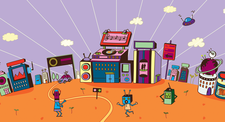USB flash drives with Live Lernstick distro deliver educational software in schools
Smart Settings

The Lernstick free distribution provides a unified and mobile environment for students and teachers. At home or in the classroom, you always have access to the same programs.
With just a USB stick and a portable hard drive or SD card, teachers of primary through secondary courses can provide their students a consistent learning experience, in and out of the classroom. The Lernstick (learning stick) distribution [1] is a slightly modified Debian 7 Live system with numerous educational programs aimed at different ages, including the 3D Marble Virtual Globe, the computer game TuxMath, a vocabulary trainer named Parley, and the music notation program Reunion (Figure 1).
 Figure 1: Lernstick comes with numerous well-known programs from a variety of disciplines, including the music notation software Reunion.
Figure 1: Lernstick comes with numerous well-known programs from a variety of disciplines, including the music notation software Reunion.
School Days
A lack of education funding means that schools are rarely able to provide their students with computers. Instead of sending parent teacher associations begging, the students could bring their own laptops to classes. This also offers the advantage of being able to continue working at home with the same device.
[...]
Buy this article as PDF
(incl. VAT)
Buy Linux Magazine
Subscribe to our Linux Newsletters
Find Linux and Open Source Jobs
Subscribe to our ADMIN Newsletters
Support Our Work
Linux Magazine content is made possible with support from readers like you. Please consider contributing when you’ve found an article to be beneficial.

News
-
Two New Distros Adopt Enlightenment
MX Moksha and AV Linux 25 join ranks with Bodhi Linux and embrace the Enlightenment desktop.
-
Solus Linux 4.8 Removes Python 2
Solus Linux 4.8 has been released with the latest Linux kernel, updated desktops, and a key removal.
-
Zorin OS 18 Hits over a Million Downloads
If you doubt Linux isn't gaining popularity, you only have to look at Zorin OS's download numbers.
-
TUXEDO Computers Scraps Snapdragon X1E-Based Laptop
Due to issues with a Snapdragon CPU, TUXEDO Computers has cancelled its plans to release a laptop based on this elite hardware.
-
Debian Unleashes Debian Libre Live
Debian Libre Live keeps your machine free of proprietary software.
-
Valve Announces Pending Release of Steam Machine
Shout it to the heavens: Steam Machine, powered by Linux, is set to arrive in 2026.
-
Happy Birthday, ADMIN Magazine!
ADMIN is celebrating its 15th anniversary with issue #90.
-
Another Linux Malware Discovered
Russian hackers use Hyper-V to hide malware within Linux virtual machines.
-
TUXEDO Computers Announces a New InfinityBook
TUXEDO Computers is at it again with a new InfinityBook that will meet your professional and gaming needs.
-
SUSE Dives into the Agentic AI Pool
SUSE becomes the first open source company to adopt agentic AI with SUSE Enterprise Linux 16.

